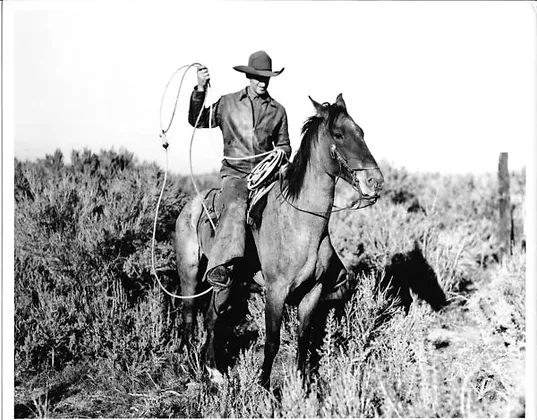Frank Benjamin Robbins, nicknamed “Wild Horse Robbins”, referred to in newspapers nationwide as the “Wild Horse King of the West”, was born November 7, 1894 in Boxelder, Wyoming. He was the youngest of six boys and a girl born to Frank Benjamin and Susie Robbins. Robbins served in the Army during World War I where he was assigned to break horses for the Remount Service. After discharge, he returned to Converse County and married Christina “Toots” Millar on May 24, 1918. They worked on the Millar Ranch in Glenrock, for a while before moving to eastern Nevada where they learned to catch wild horses from the Paiutes. The Robbins’ also lived in California, Utah and Canada for several years before returning to Wyoming.
Robbins first went to Wyoming’s Red Desert to capture wild horses in 1935; living there in the summer and constantly moving from one water hole to the next. He would catch a wild horse once in a while by using the “water hole traps” and “day herds” methods, but with very little overall success.
On March 18, 1943, the forerunner of today’s Bureau of Land Management, the U.S. Grazing Service, announced to the press, that there were about 100,000 wild horses grazing on the federal ranges. A decision was made to stop the growth and expansion of the wild herds. All horses on Wyoming’s Red Desert, not under grazing permits, were to be considered as “horses in trespass.”
A meeting was held in Rock Springs, Wyoming to create a plan of action. It was widely attended by cattle and sheep men, meat packers and canneries, mustangers and Grazing Service personnel. The heated discussions centered on destroying, and the wholesale slaughter of, “trespass horses”; either by shooting or poisoning. Robbins became the voice of reason by offering a plan, when he stated, “I’m representing the horses. I’ll trap ‘em and bring ‘em in alive.” Robbins plan was to use small, single engine airplanes to chase the wild herds to a pre-constructed horse trap. He believed his method would save time, money, horseflesh and men. Robbins method worked well and he captured thousands of horses. His efforts added greatly to Government’s war efforts to feed a starving Europe.
Robbins gained fame when he captured a golden palomino stallion. He told a Casper Star Tribune and Glenrock Independent freelance reporter that he and his hands were rounding up horses 28 miles southwest of Wamsutter, when he met up with a couple who reported they were on to “something special”. Robbins sent his pilot, Walt Williams of Laramie, to look, and what he found in the early morning of July 12, 1945 was certainly “special.” Williams chased a golden palomino stallion and his harem into the box canyon where Robbins and his mustangers completed the capture. Robbins sent word to Rawlins for photographer Verne Wood, “to come out and capture the wild palomino on film.” The newspapers reported that Robbins named him, “Desert Dust”.
Robbins produced his annual “Robbins Wild Horse Rodeo” in Glenrock, which was held on the 4th of July. The 1946 rodeo displayed Desert Dust for the first time and was attended by representatives of Universal Pictures who were filming arena events for inclusion in their forthcoming movie, Fight of the Wild Stallions. Following the rodeo, Universal caught Robbins’ unique method of capturing wild horses on film and used it in the movie. Fight of the Wild Stallions was nominated for a 1947 Academy Award. The world premier was held in Casper and exhibited in theaters around the country, reportedly seen by fifty million people.
Frank “Wild Horse” Robbins was the owner of what was said to be the only wild horse ranch in the country. He lived near Glenrock for over 40 years; running a normal ranch operation and about 400 wild horses. He died after a short illness on July 5, 1984 at the age of 89 and was buried in the Glenrock Cemetery.
Robbins’ life as a mustanger, rancher, horse breeder and cowboy is well documented in featured stories published in Western Horseman, True, the Man’s Magazine, True West and several aviation journals. He was truly a quintessential pioneer who left a lasting Wyoming legacy.


